
Velvet is a type of woven fabric with a dense, even pile that gives it a distinctive soft feel. Historically, velvet was typically made from silk. Modern velvet can be made from silk, linen, cotton, wool, synthetic fibers, silk-cotton blends, or synthetic-natural fiber blends.

A ribbon or riband is a thin band of material, typically cloth but also plastic or sometimes metal, used primarily as decorative binding and tying. Cloth ribbons are made of natural materials such as silk, cotton, and jute and of synthetic materials, such as polyester, nylon, and polypropylene. Ribbon is used for useful, ornamental, and symbolic purposes. Cultures around the world use ribbon in their hair, around the body, and as ornament on non-human animals, buildings, and packaging. Some popular fabrics used to make ribbons are satin, organza, sheer, silk, velvet, and grosgrain.

Poplin, also called tabinet, is a fine wool, cotton or silk fabric with crosswise ribs that typically give a corded surface. Nowadays, the name refers to a strong material in a plain weave of any fiber or blend.
Lawn cloth or lawn is a fine plain weave textile, made with fine combed cotton. Terms also used include batiste and nainsook. Originally the name applied to plain weave linen, and linen lawn is also called "handkerchief linen". The term lawn is also used in the textile industry to refer to a type of starched crisp finish given to a cloth product. The finish can be applied to a variety of fine fabrics, prints or plain.

Damask is a woven, reversible patterned fabric. Damasks are woven by periodically reversing the action of the warp and weft threads. The pattern is most commonly created with a warp-faced satin weave and the ground with a weft-faced or sateen weave. Yarns used to create damasks include silk, wool, linen, cotton, and synthetic fibers, but damask is best shown in cotton and linen. Over time, damask has become a broader term for woven fabrics with a reversible pattern, not just silks.
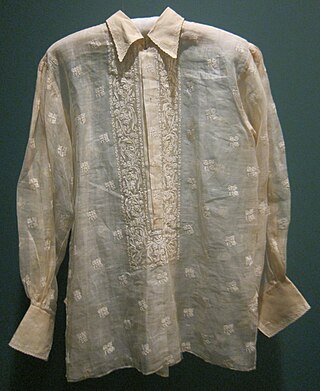
The barong tagalog, more commonly known simply as barong, is an embroidered long-sleeved formal shirt for men and a national dress of the Philippines. Barong tagalog combines elements from both the precolonial native Filipino and colonial Spanish clothing styles. It is traditionally made with sheer textiles (nipis) woven from piña or abacá; although in modern times, cheaper materials like organza silk, ramie or polyester are also used.

Tulle is a form of netting that is made of small-gauge thread, netted in a hexagonal pattern with small openings, and frequently starched to provide body or stiffness. It is a finer textile than the textile referred to as "net."

Voile is a soft, sheer fabric, usually made of 99% cotton or cotton blended with linen or polyester. Named for its light weight, the fabric is mostly used in soft furnishing. In tropical climates, voile is used for window treatments and mosquito nets. When used as curtain material, voile is similar to net curtains.

Crêpe, also spelled crepe or crape, is a silk, wool, or synthetic fiber fabric with a distinctively crisp and crimped appearance. The term "crape" typically refers to a form of the fabric associated specifically with mourning. Crêpe was also historically called "crespe" or "crisp".

Ninon is a lightweight, sheer fabric made with plain or leno weaving, it is a suitable material for curtains, evening wear and lingerie. Ninon is made with variety of filament yarns such as polyester, silk, rayon or nylon.

Chiffon (French:[ʃi.fɔ̃];, shif-ON, from the French word chiffe which means "cloth or rag"; is a lightweight, balanced plain-woven sheer fabric, or gauze, like gossamer, woven of alternate S- and Z-twist crepe yarns. Crepe yarn tends to have a tighter twist than standard yarns. The twist in the crepe yarns puckers the fabric slightly in both directions after weaving, giving it some stretch and a slightly rough feel.
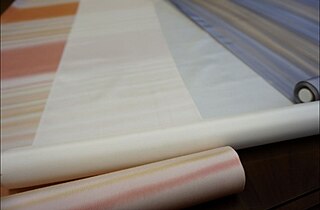
Habutai is one of the most basic plain weaves of silk fabric. While it was traditionally woven in Japan, most habutai is today woven in China. It is normally a lining silk but can also be used for T-shirts, lampshades, summer blouses or very light lingerie. It is quite easy to dye and can be found in many stores.

Plain weave is the most basic of three fundamental types of textile weaves. It is strong and hard-wearing, and is used for fashion and furnishing fabrics. Fabrics with a plain weave are generally strong, durable, and have a smooth surface. They are often used for a variety of applications, including clothing, home textiles, and industrial fabrics.
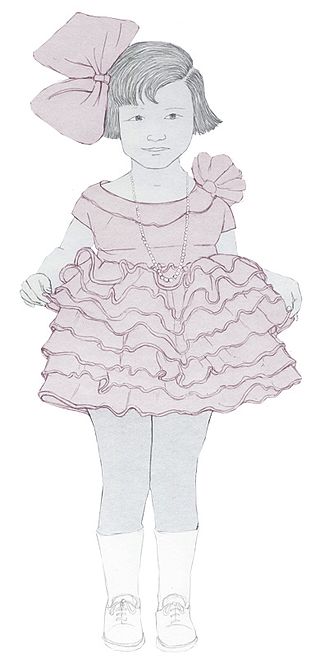
Organdy, also spelled Organdie, is a kind of fabric. It is a lightweight, balanced plain weave made of cotton with features of sheerness and crispness.
The manufacture of textiles is one of the oldest of human technologies. To make textiles, the first requirement is a source of fiber from which a yarn can be made, primarily by spinning. The yarn is processed by knitting or weaving, with color and patterns, which turns it into cloth. The machine used for weaving is the loom. For decoration, the process of coloring yarn or the finished material is dyeing. For more information of the various steps, see textile manufacturing.
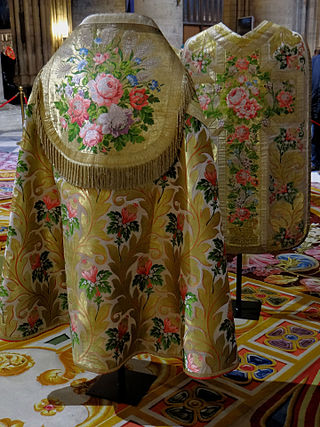
Brocade is a class of richly decorative shuttle-woven fabrics, often made in coloured silks and sometimes with gold and silver threads. The name, related to the same root as the word "broccoli", comes from Italian broccato meaning 'embossed cloth', originally past participle of the verb broccare 'to stud, set with nails', from brocco, 'small nail', from Latin broccus, 'projecting, pointed'.
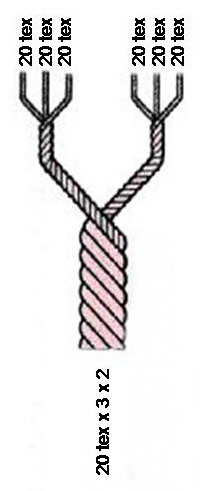
Textile fibers, threads, yarns and fabrics are measured in a multiplicity of units.

In embroidery, plainweave is a technical category of woven base fabrics that are suitable for working certain varieties of embroidery. Plainweave fabrics have a tight weave and individual threads are not readily visible. Surface embroidery may be performed on plainweave, such as crewel work, goldwork, stumpwork, cutwork, and candlewicking.

Bizarre silks are a style of figured silk fabrics popular in Europe in the late 17th and early 18th centuries. Bizarre silks are characterized by large-scale, asymmetrical patterns featuring geometrical shapes and stylized leaves and flowers, influenced by a wave of Asian textiles and decorative objects reaching the European market in these decades. Bizarre silks were used for both clothing and furnishings. As a description, the term was first used by Dr. Vilhelm Sloman in the title of a book, Bizarre Designs in Silks published in 1953 in Copenhagen.


















